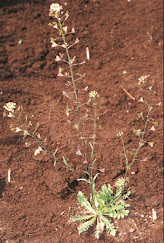I admit to the term of being 'scatterbrained', (at times). I prefer to think in terms of 'being interested in many things at the same time'. I can rationalize it another way by saying a bit of this and a bit of that keeps my mind open and my life interesting.
 |
| Pfeffernusse |
This posting was intended to be a subject entirely different but then--a friend called and wanted to share the wonders of a new cookbook of the old traditional Irish recipes. The recipes used the traditional meat cuts, vegetable names and herbs. Being of German heritage I am more familiar sauerkraut, German noodle dishes and pfeffernusse (peppernut) Christmas cookies.
My culinary world expanded, in more ways than one, with an afternoon of cookbook browsing. The cookbook concluded with information of foraging the forests, including the Irish name of the weed, a little history and how it was prepared.
The purpose of this entry is to increase our appreciation of the plants that we commonly call weeds. These weeds are just a minor sample of what may have sustained our ancestors in their nutritional and medicinal needs. I have only used the weeds that I was able to cross reference with
Weeds of the West, the reference we generally use for weed identification for our area.
 |
| Dandelion |
One of the common weeds we share, probably world wide, is the dandelion -
Taraxacum officinale from the French
dent-de-lion (meaning lion's teeth). Dandelion is considered a gateway herb for foragers. It can be blanched briefly as you would spinach, then toss with nuts and garlic. Other uses include being made into root beer, beer, wine and as a coffee substitute. Gardeners now consider it especially important for bees in the early spring.
 |
| "Fat Hen" |
Known as Fat Hen,
Chenopodium album in Ireland is a form of wild lentil. The name comes from people feeding the seeds to their hens to fatten them. Surprise, surprise, we know Fat Hen as lambsquarters. The seeds are difficult to harvest. The leaves are easy to harvest and can be used as a substitute for spinach in cooking, or basil in pesto. The young shoots can be treated like baby broccoli or pickled like lovage stalks.
 |
| Goatsbeard |
Goatsbeard-
Tragopogn pratensis is known in Ireland as Jack-go-to-bed-at-noon. Unfortunately, a brief history of the name was not given. In
Weeds of the West, goatsbeard is listed as the non-standard name for Western salsify.
 |
| Shepherd's purse |
Shepherd's purse-
Capsella bursa-pastoris is a member of the cabbage family and is good as a garnish or in salads. The herb takes its name from the resemblance of the seed cases to a purse. You can infuse the herb in boiling water to make a tea.
 |
| Yarrow |
Yarrow-
Achillea milleflorium is the European equivalent to our Western yarrow-
Achillea lanulosa. Yarrow is imbedded in folklore. People travelling on long journeys were instructed to pick ten leaves, then throw away one and put the nine remaining into a white cloth and tie with a string around your neck. This would ward off evil spirits that you may encounter along the Irish country roads. Medical properties of yarrow have been known through generations for being a remedy for colds and fevers. Yarrow leaves can also be added to a green salad. Buttered new potatoes can be dressed with young chopped leaves because the leaves taste similar to rosemary. The benefit gardeners value is that yarrow attracts pollinators.
It was an afternoon filled with many thoughts. Now I have to try and find the story behind the name -- Jack-go-to-bed-at-noon.
Tune in to next Tuesday's Gardening: Get Good at It to learn how to "Garden on a Budget" - Nov. 30 on KPOV 88.9 FM between 9-9:30 a.m.
Sources: The Irish Cookbook by JP McMahon
Weeds of the West, published in cooperation with the Western U.S. Land Grant Universities.







No comments:
Post a Comment
Let us know what you think of Gardening in Central Oregon.